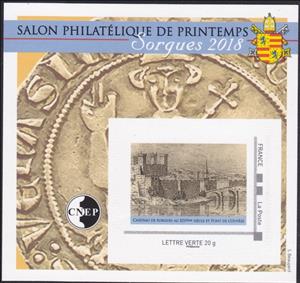Souvenir Sheet: Spring Philatelic Show Sorgues 2018 (France 2018)
Spring Philatelic Show Sorgues 2018 (France 2018)
01 January (France ) within release CNEP Collector Sheets goes into circulation Souvenir Sheet Spring Philatelic Show Sorgues 2018 face value 20 Gram
| Souvenir Sheet Spring Philatelic Show Sorgues 2018 in catalogues | |
|---|---|
| Yvert et Tellier: | Yt: FR CNEP77 |
Souvenir Sheet is square format.
Also in the issue CNEP Collector Sheets:
- Stamp - 11 November 1918. Clariere de Rethondes Armistice Signature face value 20;
- Souvenir Sheet - Autumn Philatelic Show. Paris 2018. Armistice Signature face value 20;
- Stamp - Castle. Chateau de Sorgues 16th century Pont de l'Ouveze face value 20;
- Souvenir Sheet - Paris Philex 2018 Trams face value 20;
- Souvenir Sheet - Spring Philatelic Show Sorgues 2018 face value 20;
- Stamp - Tram face value 20;
|
Data entry completed
46%
|
|
|---|---|
| Souvenir Sheet Spring Philatelic Show Sorgues 2018 in digits | |
| Country: | France |
| Date: | 2018-01-01 |
| Emission: | Personalized - Official |
| Format: | Souvenir Sheet |
| Face Value: | 20 Gram |
Souvenir Sheet Spring Philatelic Show Sorgues 2018 it reflects the thematic directions:
A bridge is a structure built to span physical obstacles without closing the way underneath such as a body of water, valley, or road, for the purpose of providing passage over the obstacle. There are many different designs that each serve a particular purpose and apply to different situations. Designs of bridges vary depending on the function of the bridge, the nature of the terrain where the bridge is constructed and anchored, the material used to make it, and the funds available to build it.
A castle (from Latin: castellum) is a type of fortified structure built in Europe and the Middle East during the Middle Ages by European nobility. Scholars debate the scope of the word castle, but usually consider it to be the private fortified residence of a lord or noble. This is distinct from a palace, which is not fortified; from a fortress, which was not always a residence for nobility; and from a fortified settlement, which was a public defence – though there are many similarities among these types of construction. Usage of the term has varied over time and has been applied to structures as diverse as hill forts and country houses. Over the approximately 900 years that castles were built, they took on a great many forms with many different features, although some, such as curtain walls and arrowslits, were commonplace.
A coin is a small object, usually round and flat, used primarily as a medium of exchange or legal tender. They are standardized in weight, and produced in large quantities at a mint in order to facilitate trade. They are most often issued by a government. Coins often have images, numerals, or text on them. The faces of coins or medals are sometimes called the obverse and the reverse, referring to the front and back sides, respectively. The obverse of a coin is commonly called heads, because it often depicts the head of a prominent person, and the reverse is known as tails.
Logos is a term used in Western philosophy, psychology and rhetoric, as well as religion (notably Christianity); among its connotations is that of a rational form of discourse that relies on inductive and deductive reasoning.




